stop start FORD F650 2002 10.G User Guide
[x] Cancel search | Manufacturer: FORD, Model Year: 2002, Model line: F650, Model: FORD F650 2002 10.GPages: 256, PDF Size: 1.75 MB
Page 139 of 256
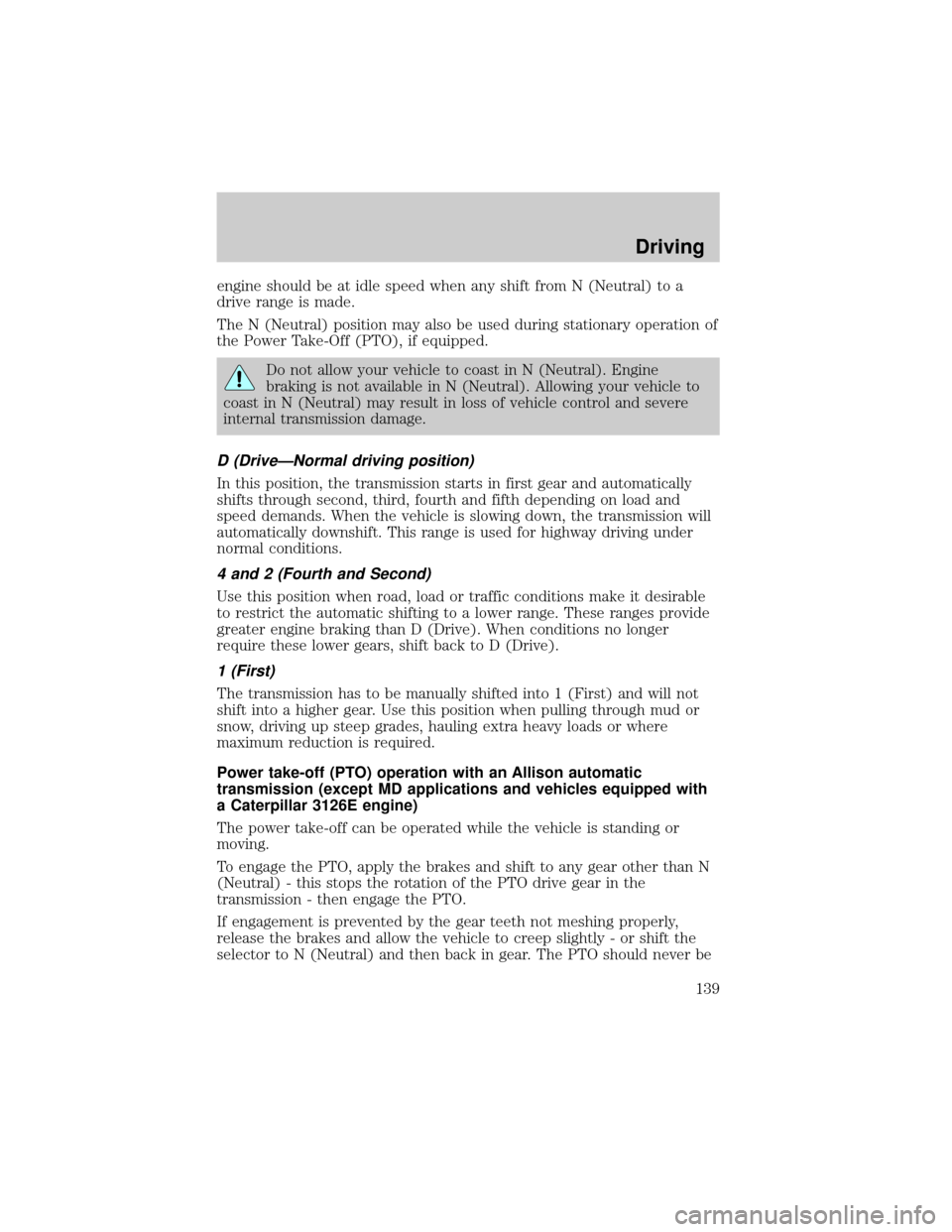
engine should be at idle speed when any shift from N (Neutral) to a
drive range is made.
The N (Neutral) position may also be used during stationary operation of
the Power Take-Off (PTO), if equipped.
Do not allow your vehicle to coast in N (Neutral). Engine
braking is not available in N (Neutral). Allowing your vehicle to
coast in N (Neutral) may result in loss of vehicle control and severe
internal transmission damage.
D (DriveÐNormal driving position)
In this position, the transmission starts in first gear and automatically
shifts through second, third, fourth and fifth depending on load and
speed demands. When the vehicle is slowing down, the transmission will
automatically downshift. This range is used for highway driving under
normal conditions.
4 and 2 (Fourth and Second)
Use this position when road, load or traffic conditions make it desirable
to restrict the automatic shifting to a lower range. These ranges provide
greater engine braking than D (Drive). When conditions no longer
require these lower gears, shift back to D (Drive).
1 (First)
The transmission has to be manually shifted into 1 (First) and will not
shift into a higher gear. Use this position when pulling through mud or
snow, driving up steep grades, hauling extra heavy loads or where
maximum reduction is required.
Power take-off (PTO) operation with an Allison automatic
transmission (except MD applications and vehicles equipped with
a Caterpillar 3126E engine)
The power take-off can be operated while the vehicle is standing or
moving.
To engage the PTO, apply the brakes and shift to any gear other than N
(Neutral) - this stops the rotation of the PTO drive gear in the
transmission - then engage the PTO.
If engagement is prevented by the gear teeth not meshing properly,
release the brakes and allow the vehicle to creep slightly - or shift the
selector to N (Neutral) and then back in gear. The PTO should never be
Driving
139
Page 154 of 256
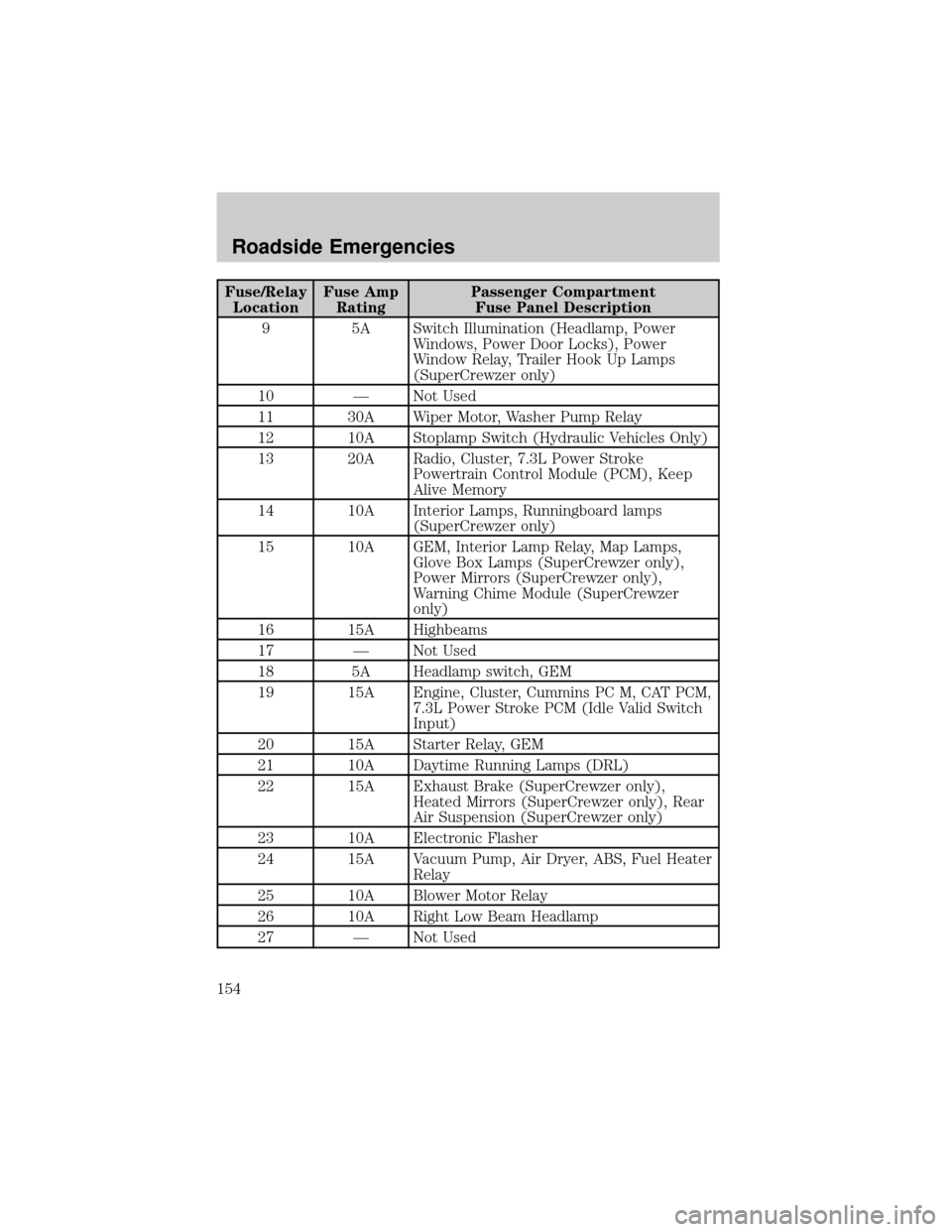
Fuse/Relay
LocationFuse Amp
RatingPassenger Compartment
Fuse Panel Description
9 5A Switch Illumination (Headlamp, Power
Windows, Power Door Locks), Power
Window Relay, Trailer Hook Up Lamps
(SuperCrewzer only)
10 Ð Not Used
11 30A Wiper Motor, Washer Pump Relay
12 10A Stoplamp Switch (Hydraulic Vehicles Only)
13 20A Radio, Cluster, 7.3L Power Stroke
Powertrain Control Module (PCM), Keep
Alive Memory
14 10A Interior Lamps, Runningboard lamps
(SuperCrewzer only)
15 10A GEM, Interior Lamp Relay, Map Lamps,
Glove Box Lamps (SuperCrewzer only),
Power Mirrors (SuperCrewzer only),
Warning Chime Module (SuperCrewzer
only)
16 15A Highbeams
17 Ð Not Used
18 5A Headlamp switch, GEM
19 15A Engine, Cluster, Cummins PC M, CAT PCM,
7.3L Power Stroke PCM (Idle Valid Switch
Input)
20 15A Starter Relay, GEM
21 10A Daytime Running Lamps (DRL)
22 15A Exhaust Brake (SuperCrewzer only),
Heated Mirrors (SuperCrewzer only), Rear
Air Suspension (SuperCrewzer only)
23 10A Electronic Flasher
24 15A Vacuum Pump, Air Dryer, ABS, Fuel Heater
Relay
25 10A Blower Motor Relay
26 10A Right Low Beam Headlamp
27 Ð Not Used
Roadside Emergencies
154
Page 158 of 256
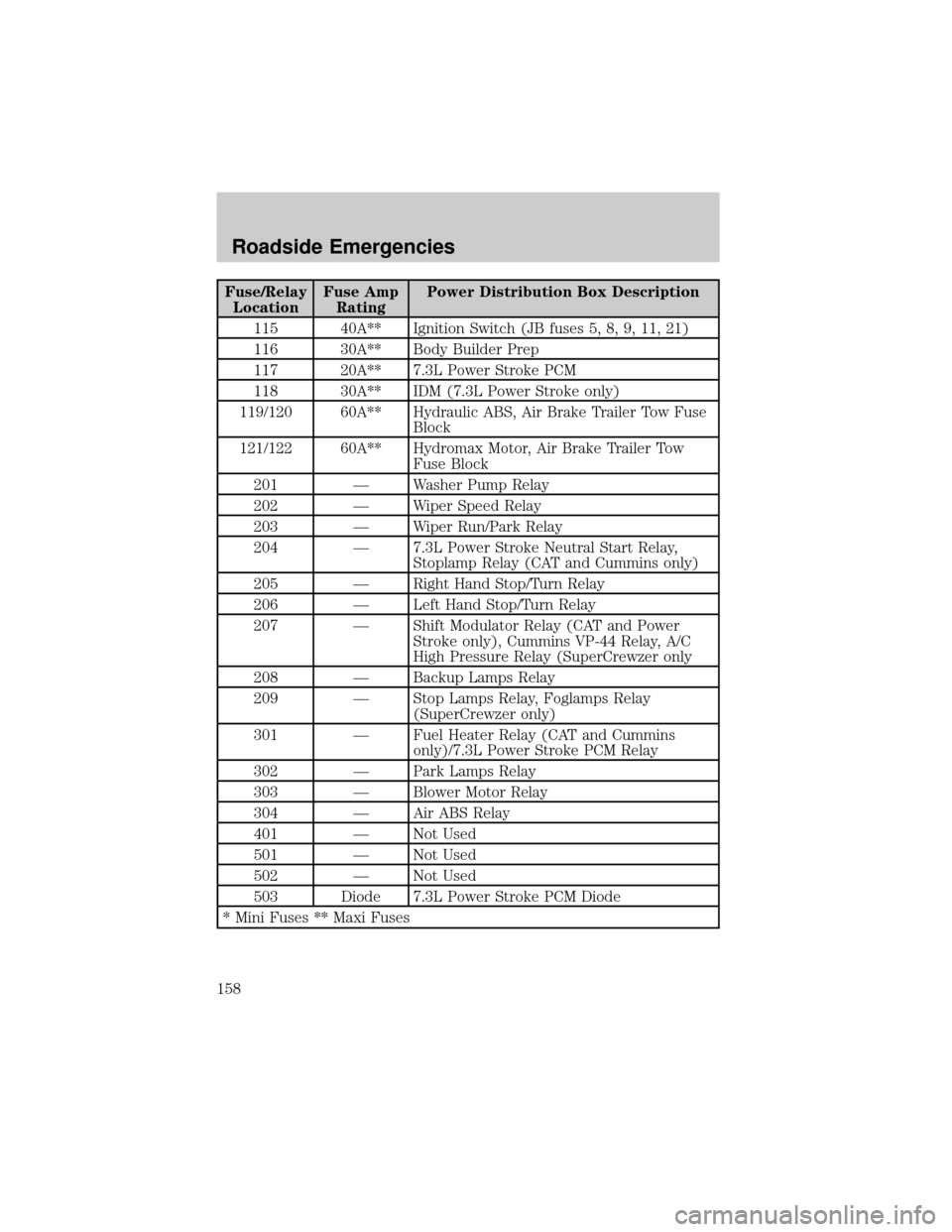
Fuse/Relay
LocationFuse Amp
RatingPower Distribution Box Description
115 40A** Ignition Switch (JB fuses 5, 8, 9, 11, 21)
116 30A** Body Builder Prep
117 20A** 7.3L Power Stroke PCM
118 30A** IDM (7.3L Power Stroke only)
119/120 60A** Hydraulic ABS, Air Brake Trailer Tow Fuse
Block
121/122 60A** Hydromax Motor, Air Brake Trailer Tow
Fuse Block
201 Ð Washer Pump Relay
202 Ð Wiper Speed Relay
203 Ð Wiper Run/Park Relay
204 Ð 7.3L Power Stroke Neutral Start Relay,
Stoplamp Relay (CAT and Cummins only)
205 Ð Right Hand Stop/Turn Relay
206 Ð Left Hand Stop/Turn Relay
207 Ð Shift Modulator Relay (CAT and Power
Stroke only), Cummins VP-44 Relay, A/C
High Pressure Relay (SuperCrewzer only
208 Ð Backup Lamps Relay
209 Ð Stop Lamps Relay, Foglamps Relay
(SuperCrewzer only)
301 Ð Fuel Heater Relay (CAT and Cummins
only)/7.3L Power Stroke PCM Relay
302 Ð Park Lamps Relay
303 Ð Blower Motor Relay
304 Ð Air ABS Relay
401 Ð Not Used
501 Ð Not Used
502 Ð Not Used
503 Diode 7.3L Power Stroke PCM Diode
* Mini Fuses ** Maxi Fuses
Roadside Emergencies
158
Page 198 of 256
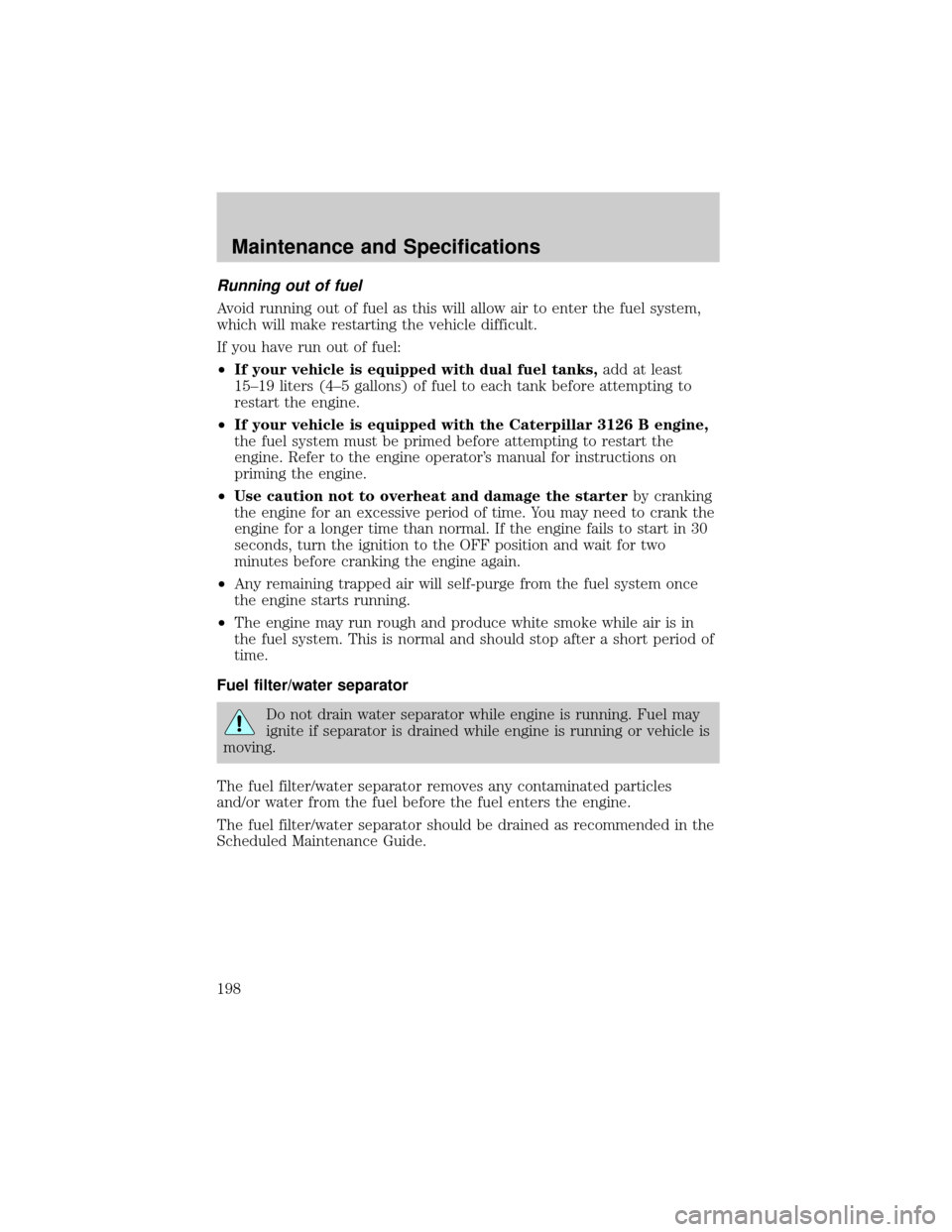
Running out of fuel
Avoid running out of fuel as this will allow air to enter the fuel system,
which will make restarting the vehicle difficult.
If you have run out of fuel:
²If your vehicle is equipped with dual fuel tanks,add at least
15±19 liters (4±5 gallons) of fuel to each tank before attempting to
restart the engine.
²If your vehicle is equipped with the Caterpillar 3126 B engine,
the fuel system must be primed before attempting to restart the
engine. Refer to the engine operator's manual for instructions on
priming the engine.
²Use caution not to overheat and damage the starterby cranking
the engine for an excessive period of time. You may need to crank the
engine for a longer time than normal. If the engine fails to start in 30
seconds, turn the ignition to the OFF position and wait for two
minutes before cranking the engine again.
²Any remaining trapped air will self-purge from the fuel system once
the engine starts running.
²The engine may run rough and produce white smoke while air is in
the fuel system. This is normal and should stop after a short period of
time.
Fuel filter/water separator
Do not drain water separator while engine is running. Fuel may
ignite if separator is drained while engine is running or vehicle is
moving.
The fuel filter/water separator removes any contaminated particles
and/or water from the fuel before the fuel enters the engine.
The fuel filter/water separator should be drained as recommended in the
Scheduled Maintenance Guide.
Maintenance and Specifications
198
Page 225 of 256
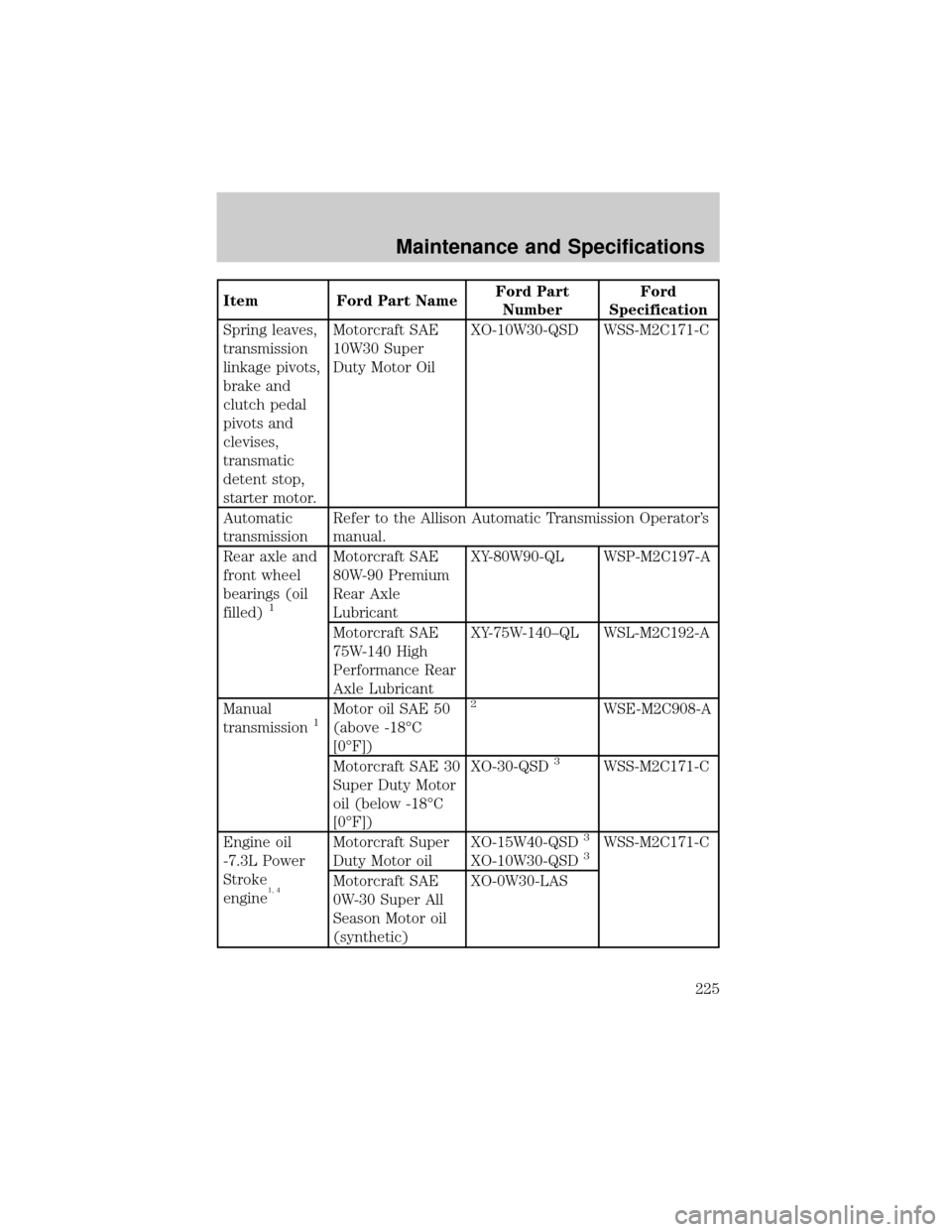
Item Ford Part NameFord Part
NumberFord
Specification
Spring leaves,
transmission
linkage pivots,
brake and
clutch pedal
pivots and
clevises,
transmatic
detent stop,
starter motor.Motorcraft SAE
10W30 Super
Duty Motor OilXO-10W30-QSD WSS-M2C171-C
Automatic
transmissionRefer to the Allison Automatic Transmission Operator's
manual.
Rear axle and
front wheel
bearings (oil
filled)
1
Motorcraft SAE
80W-90 Premium
Rear Axle
LubricantXY-80W90-QL WSP-M2C197-A
Motorcraft SAE
75W-140 High
Performance Rear
Axle LubricantXY-75W-140±QL WSL-M2C192-A
Manual
transmission
1Motor oil SAE 50
(above -18ÉC
[0ÉF])2WSE-M2C908-A
Motorcraft SAE 30
Super Duty Motor
oil (below -18ÉC
[0ÉF])XO-30-QSD
3WSS-M2C171-C
Engine oil
-7.3L Power
Stroke
engine
1, 4
Motorcraft Super
Duty Motor oilXO-15W40-QSD3
XO-10W30-QSD3WSS-M2C171-C
Motorcraft SAE
0W-30 Super All
Season Motor oil
(synthetic)XO-0W30-LAS
Maintenance and Specifications
225
Page 243 of 256
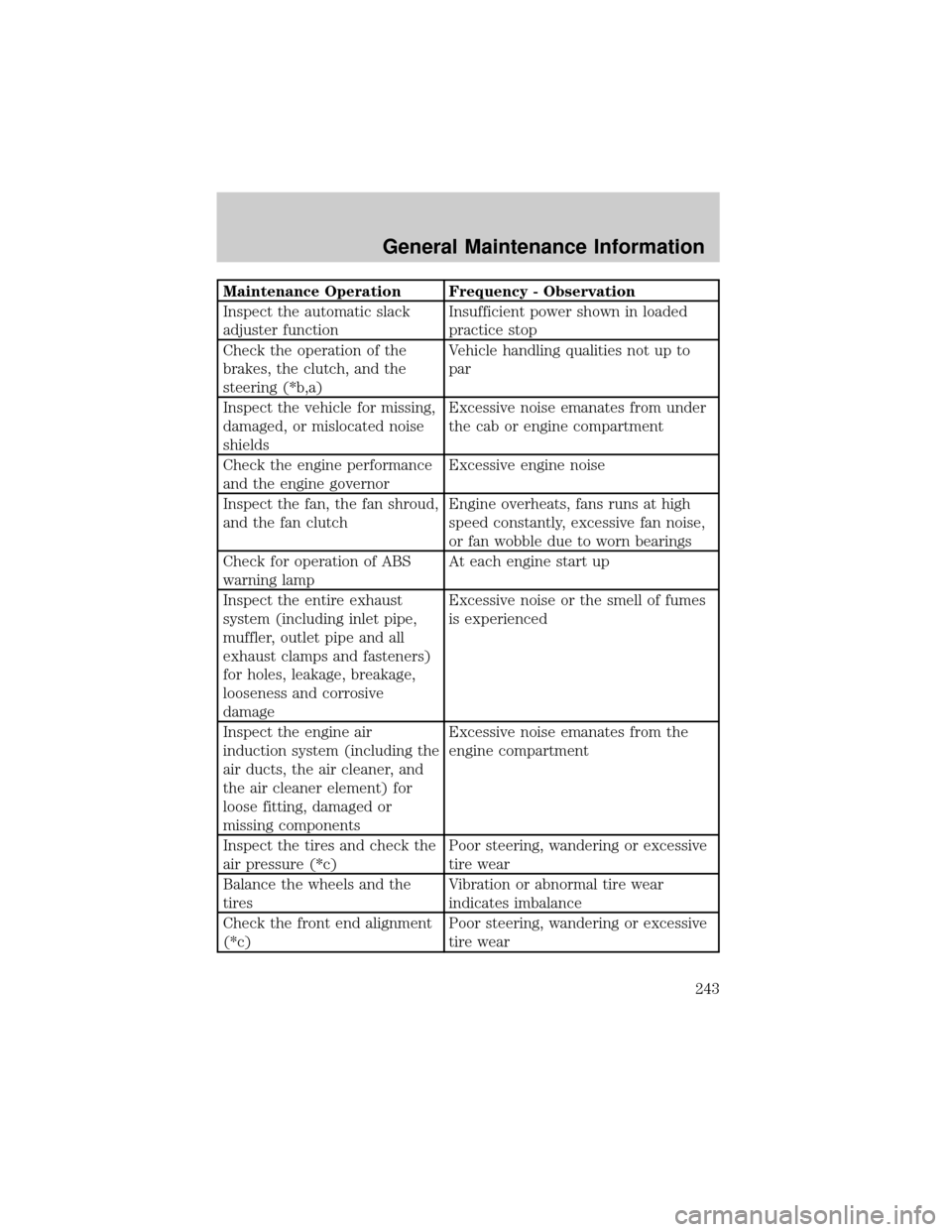
Maintenance Operation Frequency - Observation
Inspect the automatic slack
adjuster functionInsufficient power shown in loaded
practice stop
Check the operation of the
brakes, the clutch, and the
steering (*b,a)Vehicle handling qualities not up to
par
Inspect the vehicle for missing,
damaged, or mislocated noise
shieldsExcessive noise emanates from under
the cab or engine compartment
Check the engine performance
and the engine governorExcessive engine noise
Inspect the fan, the fan shroud,
and the fan clutchEngine overheats, fans runs at high
speed constantly, excessive fan noise,
or fan wobble due to worn bearings
Check for operation of ABS
warning lampAt each engine start up
Inspect the entire exhaust
system (including inlet pipe,
muffler, outlet pipe and all
exhaust clamps and fasteners)
for holes, leakage, breakage,
looseness and corrosive
damageExcessive noise or the smell of fumes
is experienced
Inspect the engine air
induction system (including the
air ducts, the air cleaner, and
the air cleaner element) for
loose fitting, damaged or
missing componentsExcessive noise emanates from the
engine compartment
Inspect the tires and check the
air pressure (*c)Poor steering, wandering or excessive
tire wear
Balance the wheels and the
tiresVibration or abnormal tire wear
indicates imbalance
Check the front end alignment
(*c)Poor steering, wandering or excessive
tire wear
General Maintenance Information
243